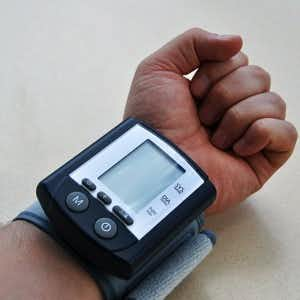
People with elevated blood pressure are often encouraged to monitor it at home. That way they can tell how their blood pressure responds to a variety of conditions throughout the day.
Home blood pressure monitors have become sophisticated, easy to use and portable. However, researchers have wondered about the accuracy of these electronic blood pressure monitors.
What the Italian Researchers Uncovered:
Italian scientists did a study of 721 hypertensive patients and found that wrist blood pressure monitors are less accurate than those that use a cuff higher on the arm (Hypertension, online Aug. 22, 2016). 620 of the people in the study had a significant discrepancy between blood pressure measurements. It’s not that the wrist monitors themselves are inaccurate or flawed. The problem appears to be primarily with the user.
Correct Placement of the Arm is Crucial:
For accurate measurements blood pressure monitors require that the arm and the wrist be positioned at heart level, and people often don’t know about this or aren’t able to do it. Failure to have the wrist at the correct position can lead to a falsely elevated reading and might result in people being treated unnecessarily.
Here is what the researchers noted:
“Upper-arm automatic devices gave fresh impetus to home self-measurement because of their user friendliness, the only conditions to be respected being adequate cuff dimensions and correct positioning of the cuff on the patient’s arm.
“For reasons of market penetration and following a general tendency to miniaturization, many wrist devices recently appeared on the market having the advantage of being smaller and easier to fit than upper-arm monitors, and today wrist devices are used by a large portion of people who measure their BP at home. However, in spite of technical improvement, their reliability in real-life conditions is not unanimously accepted.”
Here is what the researchers found about blood pressure monitors:
“The main finding of our study is that the relationship between BP measured at the upper-arm and at the wrist varied according to whether BP measurements were made in the office under a doctor’s supervision or at home in a real-life situation. When BP was taken in the office, the values measured at the wrist were, as shown by others, slightly lower than those measured at the upper-arm. In contrast, when BP was self-measured at home by the study participants, higher BP values were obtained at the wrist than at the arm.”
The Key Findings About Blood Pressure Monitors:
When people take their blood pressure with a wrist monitor there is a significant likelihood that they will not have their wrist at heart level. Chances are good that their arm will be resting on an arm of a chair or in their lap. This will falsely elevate their blood pressure by as much as 10 or more points. That is enough to lead to a false diagnosis of hypertension.
What we have observed at a major teaching hospital:
Duke University Hospital likes to pride itself on exceptional care but we have observed that one of the most fundamental measurements that the hospital requires (blood pressure) is often done incorrectly. At virtually every outpatient visit an aide weighs patients, takes their temperature and measures their blood pressure. Rarely is there any effort to follow the American Heart Association’s guidelines to have the arm supported at heart level.
We wonder how many other hospitals, clinics and doctors’ offices strictly follow the AHA guidelines.
Blood Pressure Management:
If you would like to learn precisely how to take your blood pressure correctly, you may wish to consult our Guide to Blood Pressure Treatment. We have recommendations on how to get an accurate reading and a variety of strategies to manage blood pressure with and without medication.
Here is one tip that you should always implement. NEVER talk when you are having your blood pressure taken. Talking can falsely elevate your numbers to a surprising degree. We offer a number of Dos and Dont’s of Managing Blood Pressure in our Guide.

